Microsoft Purview vs Databricks Unity Catalog: Which Solution Best Meets Your Data Governance Needs?
Share this article
Microsoft Purview and Databricks Unity Catalog are data governance tools with unique strengths and capabilities tailored to specific ecosystems. However, ensuring comprehensive data governance requires pairing them with best-in-class data governance platforms like Atlan.
This article compares Microsoft Purview vs Databricks Unity Catalog, discussing critical factors like data discovery, lineage, security, integrations, cost, and deployment. We’ll explore their nuances and trade-offs and then consider alternatives to strengthen and streamline your data governance efforts.
Table of Contents #
- Microsoft Purview vs. Databricks Unity Catalog: An overview
- Choosing the right data governance tool: 6 primary factors to consider
- Microsoft Purview vs Databricks Unity Catalog: Enriched data governance with Atlan
- Beyond the basics: Elevate your data governance efforts with Atlan
- Related reads
Microsoft Purview vs. Databricks Unity Catalog: An overview #
Before performing an in-depth comparison of Microsoft Purview and Databricks Unity Catalog, let’s take a quick refresher highlighting each tool’s origins, primary use cases, and core features.
Microsoft Purview #
Generally available since 2021, Microsoft Purview (previously known as Azure Purview) is a unified data governance solution for the Azure ecosystem, which includes Azure Synapse Analytics, SQL Server, Power BI, Azure SQL, Microsoft 365, and more recently, Microsoft Fabric.
It offers several applications to search and discover Azure data assets, get a holistic view of your data, track column-level lineage, label sensitive assets, monitor key health metrics, and manage access controls.
“By bringing together the former Azure Purview and the former Microsoft 365 Compliance portfolio under one brand, Microsoft Purview can help you understand and govern the data across your estate, safeguard that data wherever it lives, and improve your risk and compliance posture.” Microsoft
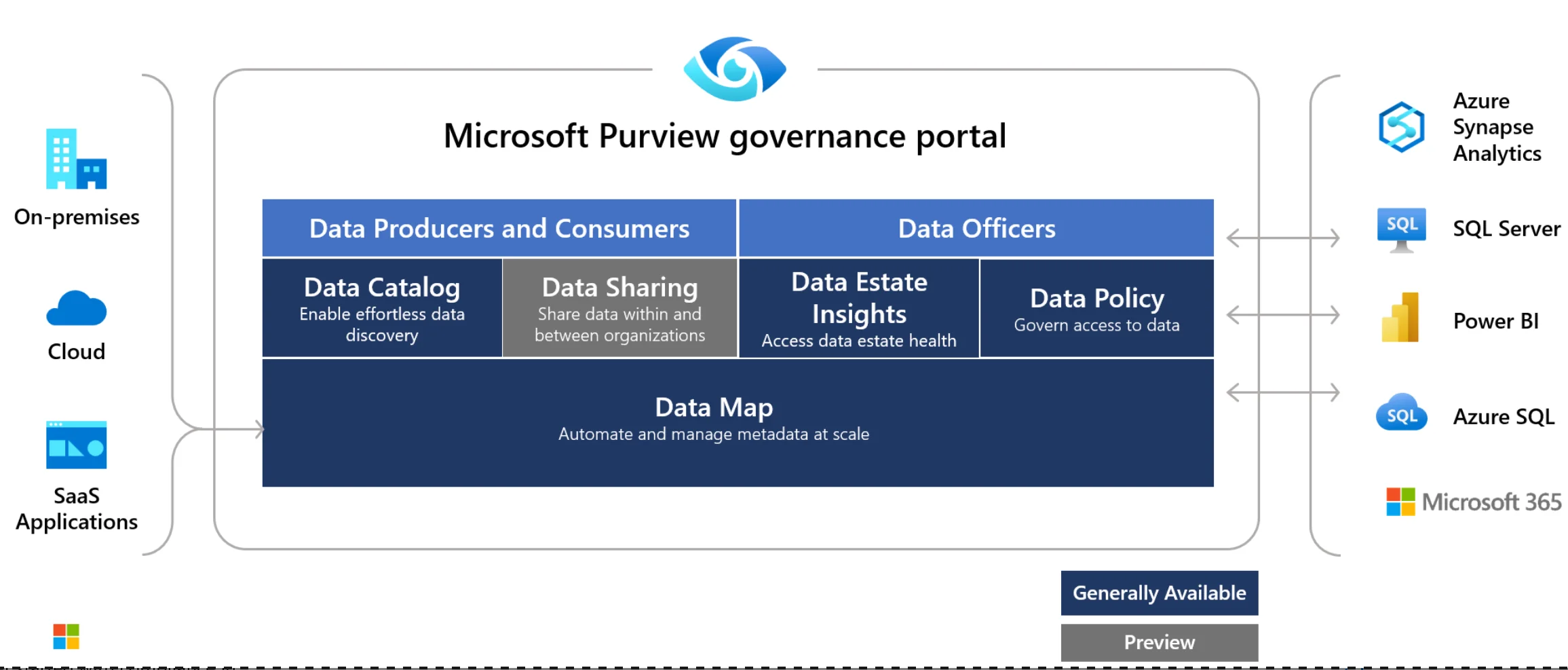
Microsoft Purview governance portal - Image by Microsoft Purview Documentation.
Databricks Unity Catalog #
Databricks Unity Catalog is a data cataloging, discovery, and governance solution for the Databricks ecosystem.
Introduced in 2021, Unity Catalog offers a cloud-agnostic approach to data lake governance. It has built-in data search and discovery, automated lineage, granular access controls, AI-powered monitoring and observability, and open data sharing.
“Our vision behind Unity Catalog is to unify governance for all data and AI assets—dashboards, notebooks, and machine learning models—in the lakehouse with a common governance model across clouds.” Databricks
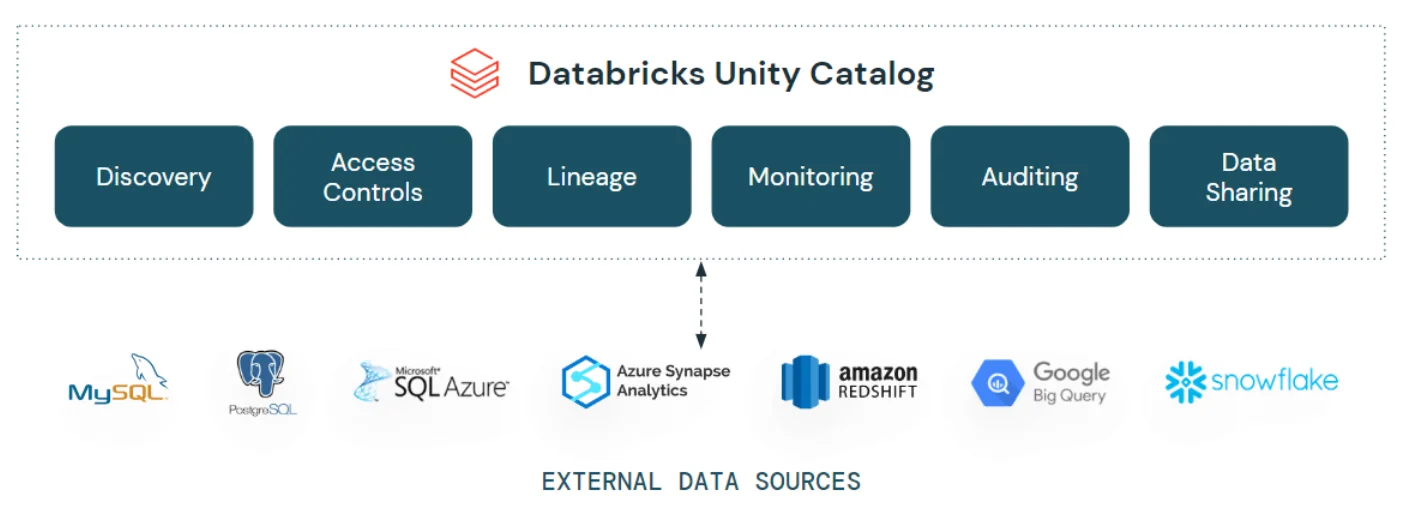
Read more → Data Unity Catalog: Purpose, Features, Architecture, and Use
Now, let’s roll up our sleeves and compare these tools in detail, especially their data governance capabilities. We’ll look into six primary factors to compare Microsoft Purview vs Databricks Unity Catalog.
Choosing the right data governance tool: 6 primary factors to consider #
We’ll be considering six primary comparison factors to understand the nuances and trade-offs between Microsoft Purview and Databricks Unity Catalog, which include:
- Data discovery: Allow users to search for data assets easily, view detailed information about them (like format, location, and description), and understand how the data is used within the organization.
- Lineage: Map how data flows from its initial source (e.g., sensor readings, customer records) to its final destination (e.g., reports, dashboards). This helps understand data dependencies, identify potential errors, and ensure data quality.
- Security and access control: Offer features for defining user permissions, granting access based on roles, and monitoring data activity. This also supports encryption and other security measures to safeguard sensitive information.
- Integration with existing tools: Integrate seamlessly with the data tools and platforms you already use — data warehouses, analytics platforms, business intelligence tools, and identity management systems. This eliminates the need for manual data transfers and siloed governance processes.
- Cost: Gauge costs by considering the tool’s value proposition, TCO (total cost of ownership), and impact on improving data governance efficiency.
- Deployment and management: Evaluate the technical expertise needed to manage the tool and ensure it fits into your existing infrastructure.
Let’s get into the specifics of each factor.
1. Data discovery #
Both Microsoft Purview and Databricks Unity Catalog offer search interfaces to help users find the data assets they need.
However, they take slightly different approaches—while Purview’s search works for a broader scope (on-premises, multi-cloud, and SaaS sources), Unity Catalog’s search is optimized for data and AI assets in the lakehouse.
Microsoft Purview focuses on understanding data assets within the context of your business. Its search interface allows natural language search and filtering by business domain, ensuring users discover data relevant to their specific needs.
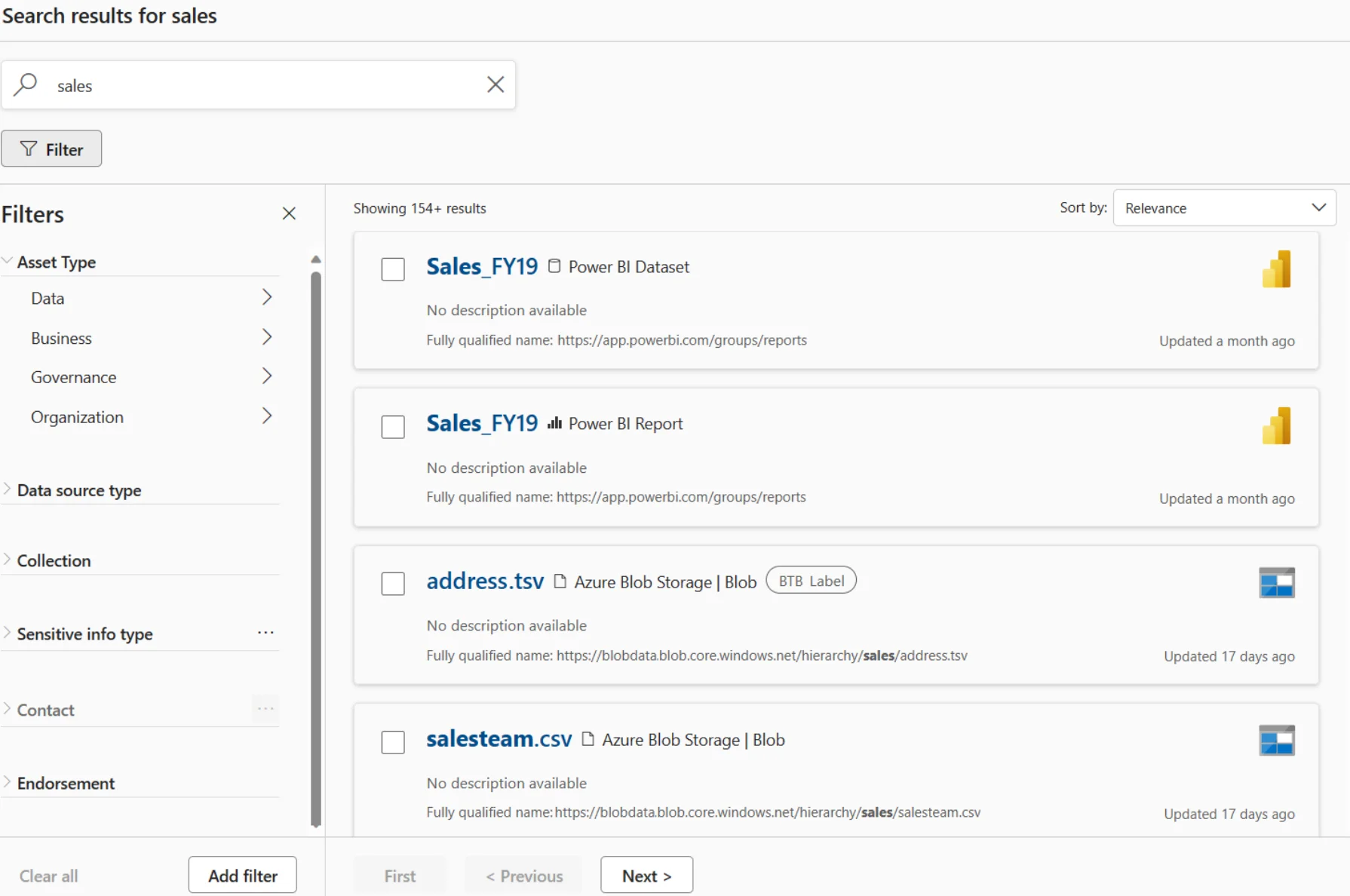
The Microsoft Purview Data Catalog search interface - Image by Microsoft Documentation.
Purview also facilitates grouping related data assets into data products for streamlined bulk requests. It leverages an AI-powered Copilot to recommend relevant data products and assets based on user natural language queries.
Databricks Unity Catalog supports natural language search, enabling users to find data and AI assets using everyday language. Its capabilities, such as insights on data popularity, ownership, tags, and freshness, are exclusive for Databricks users.
Also, unlike Microsoft Purview, Databricks Unity Catalog offers a simpler search interface, primarily focused on basic metadata like table names, column names, and descriptions.
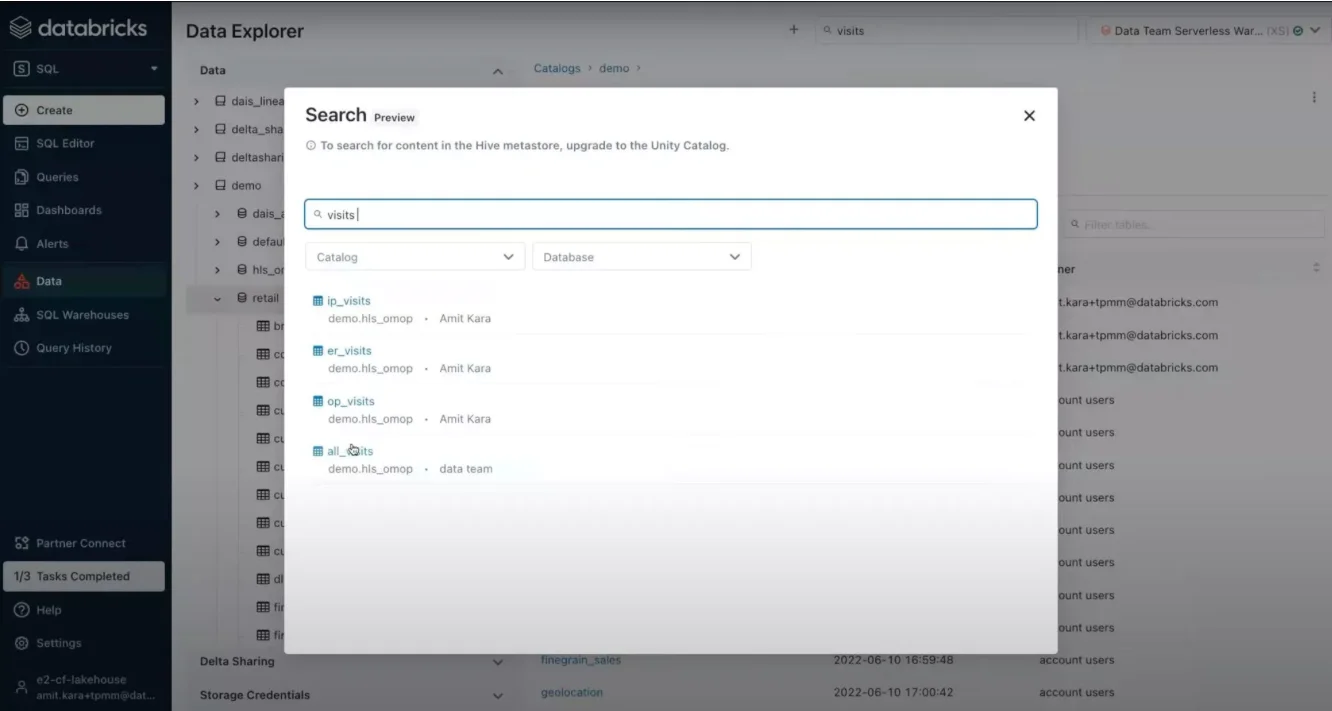
Unity Data Catalog Search and Discovery - Image by A tutorial by Amit Kara of Databricks on the official Databricks YouTube channel.
While both platforms excel at lineage within their ecosystems, organizations with complex data pipelines spanning multiple platforms might face limitations.
That’s where a comprehensive platform like Atlan can help — it integrates with Microsoft Purview and Databricks Unity Catalog via REST APIs, while connecting with the rest of your stack with native connectors. As a result, you can search and discover data assets (in natural language) across your entire data estate.
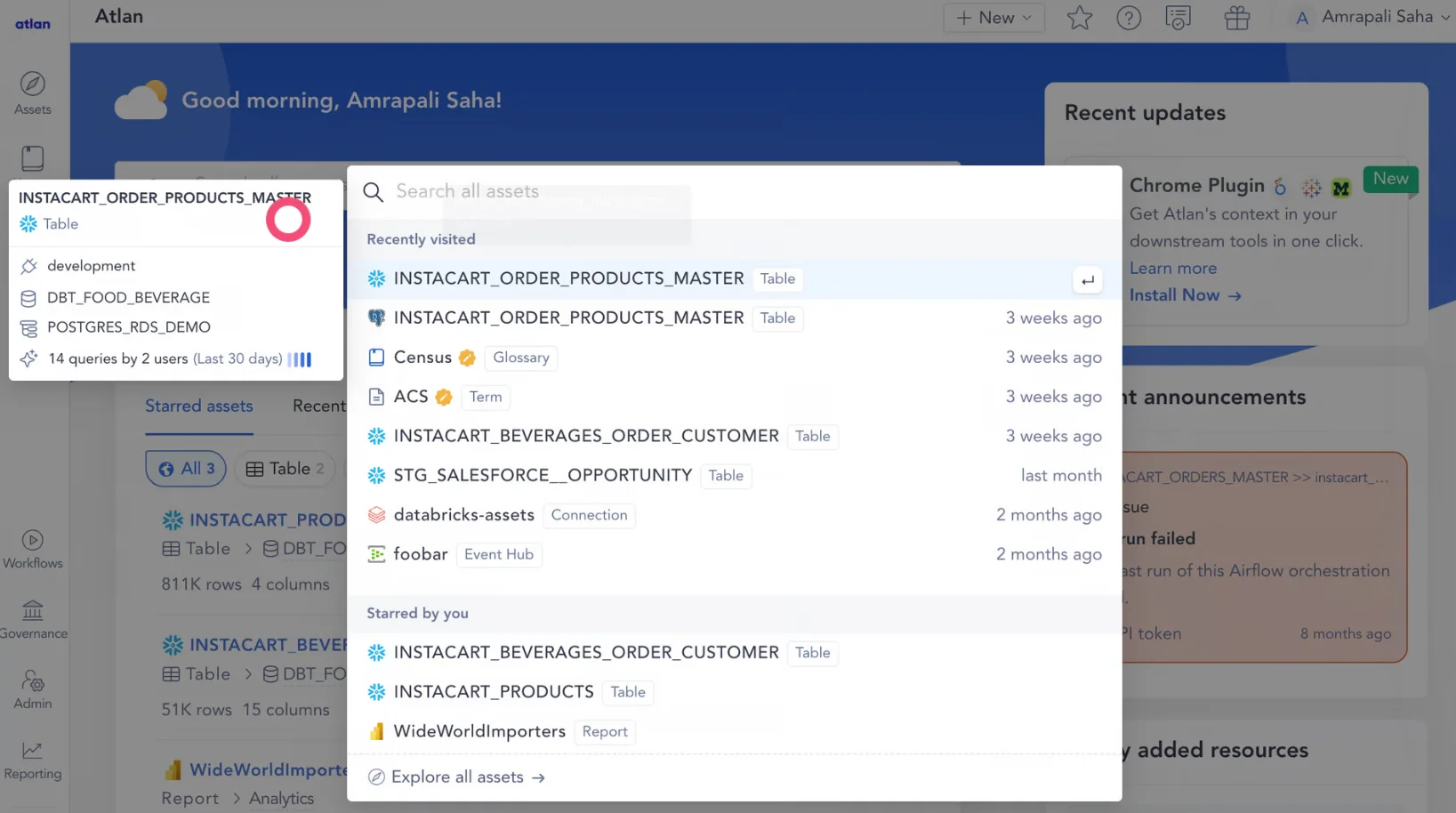
Data asset search and discovery in Atlan - Image by Atlan.
Next, let’s compare Microsoft Purview vs Databricks Unity Catalog in terms of their lineage capabilities.
2. Lineage #
Understanding how data flows through your organization is crucial for troubleshooting issues and increasing trust in data. That’s where lineage plays a central role.
Microsoft Purview offers two data lineage tracking options:
- Entity level: Provides a high-level graph of data flow, capturing movement from the source to their destinations. It also includes ownership and other metadata for clarity.
- Column (or attribute) level: Allows for a more granular examination, identifying how individual data attributes transform from source to target entities.
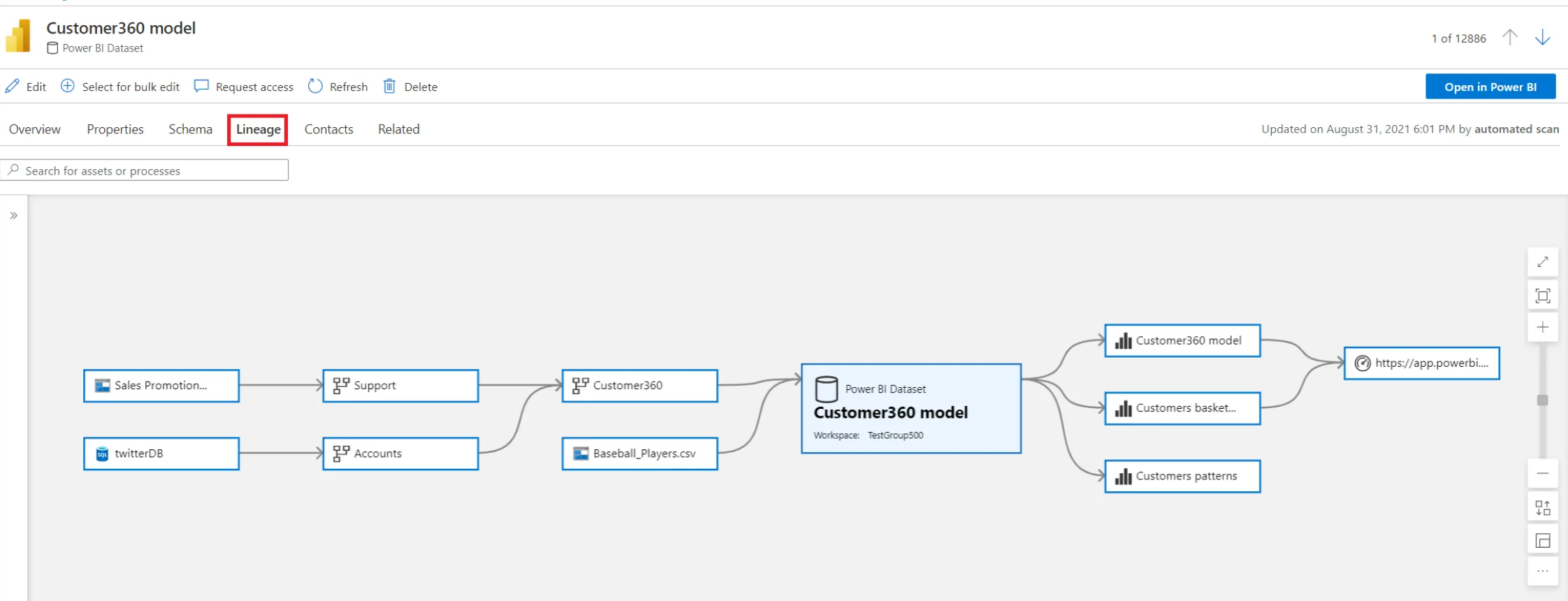
An example of lineage mapping in Microsoft Purview - Image by Microsoft Documentation.
Additionally, Purview captures the status of data processing job execution to support root cause analysis and data quality efforts. Purview also allows users to create custom lineage definitions manually or through its REST APIs.
Databricks Unity Catalog provides automatic data lineage capture for various data assets within your Databricks workspace. This includes tables, columns, dashboards, workflows, notebooks, external sources, and data models.
The captured lineage is more granular in nature, when compared to Microsoft Purview. It helps visualize column-level transformations and isn’t limited to SQL (available for any code you write in your workspace).

An example of lineage mapping in Databricks Unity Catalog - Image by Databricks Documentation.
As with data discovery, data lineage is a capability that becomes complex for multi-cloud environments. Both platforms trace lineage granularly within their ecosystems, however, they might not be effective for cross-system data infrastructure.
Moreover, both platforms help you visualize column-level lineage, but don’t support in-line actions, requiring you to switch across apps to perform comprehensive root cause and impact analysis.
Atlan offers lineage as a single pane of glass, integrating metadata from across systems and multi-cloud environments with native connectors and REST APIs.
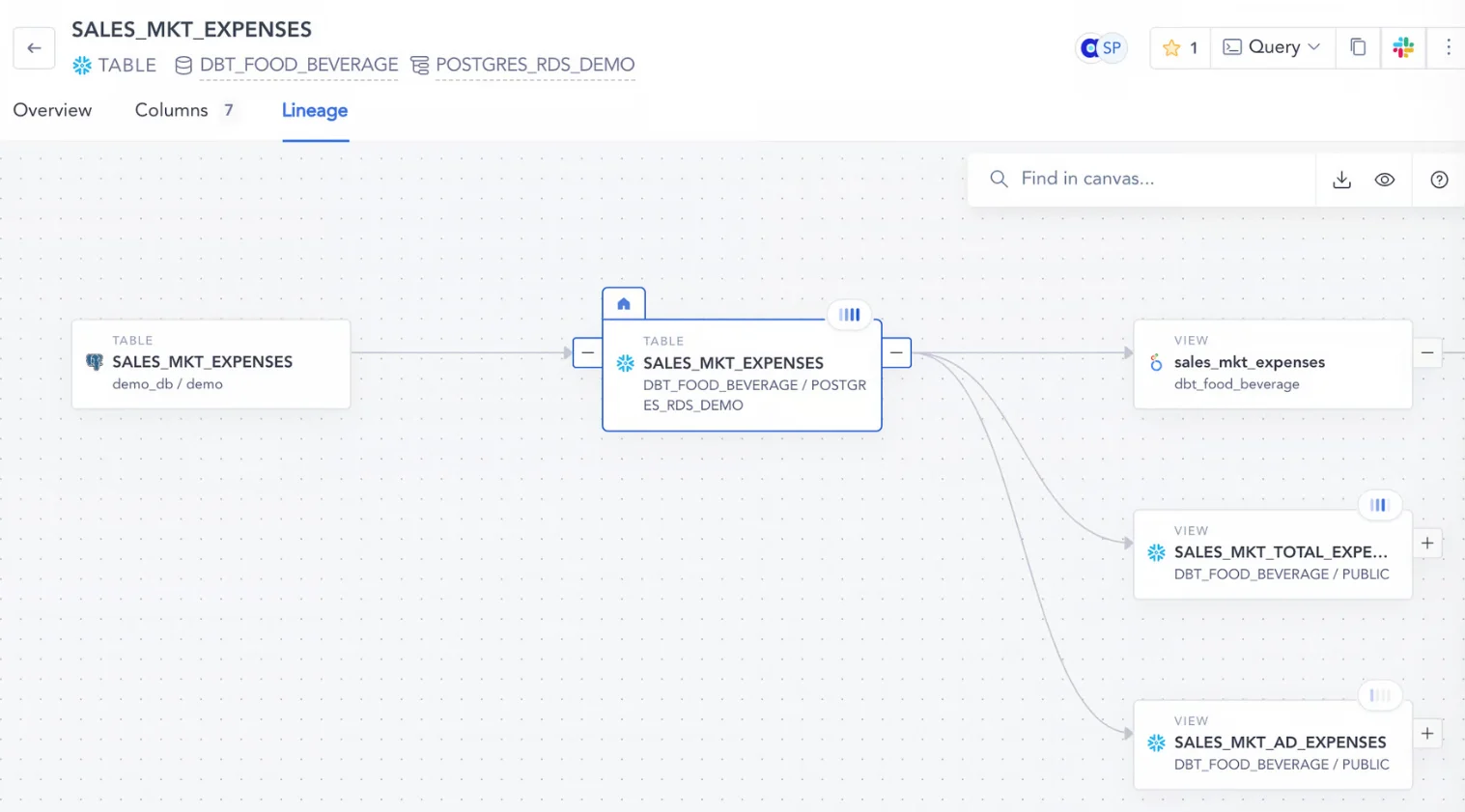
lineage map in atlan - Image by Atlan.
Atlan’s lineage mapping is also intuitive and actionable — you can analyze pipelines and raise Jira support tickets, have Slack discussions, or alert downstream consumers without leaving Atlan. This sort of embedded collaboration speeds up root cause and impact analysis, reduces pipeline downtime, and enhances productivity.
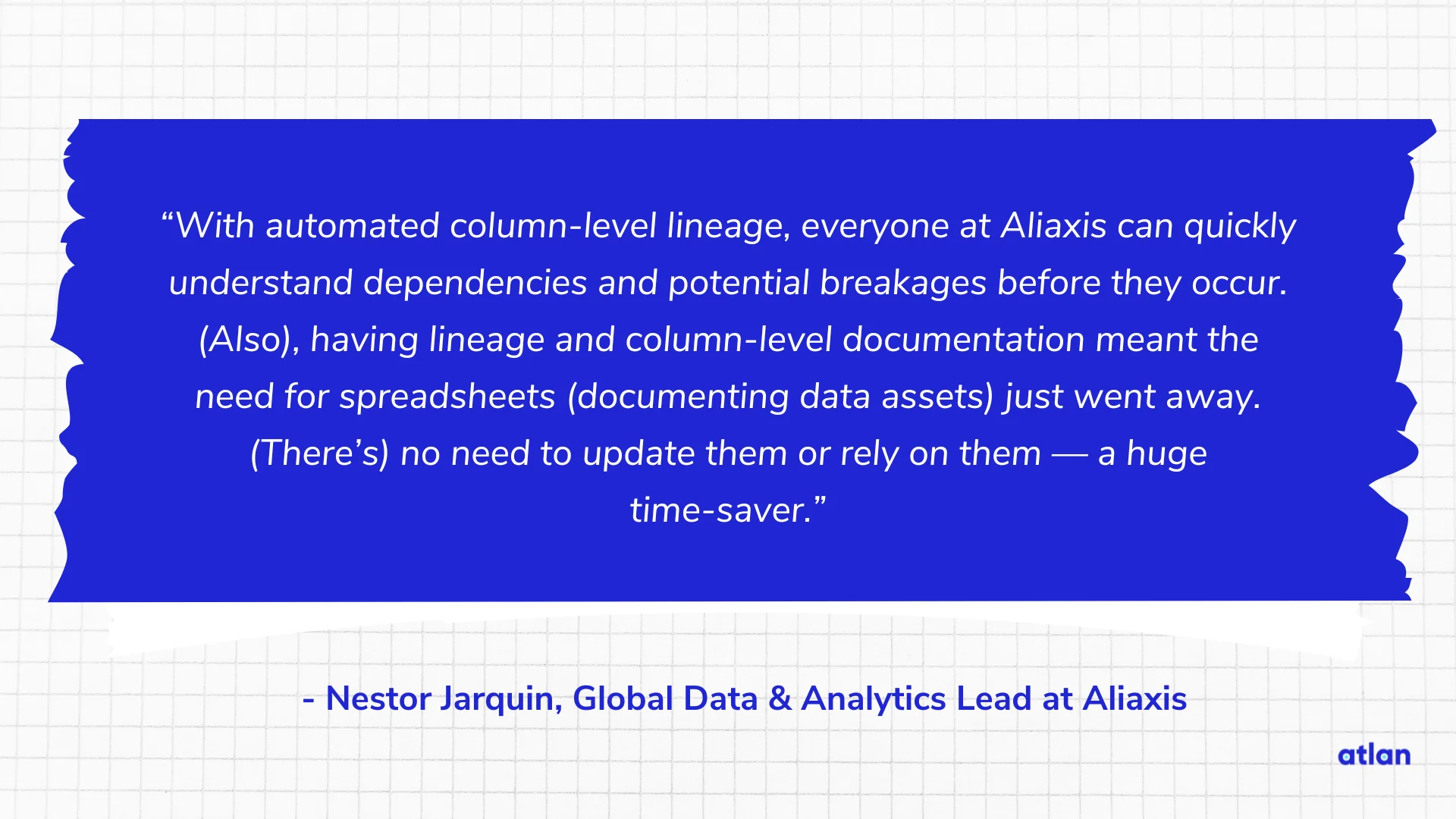
Aliaxis can quickly understand dependencies and potential breakages before they occur - Image by Atlan.
Next up, data security and access — critical components of your data governance program.
3. Security and access control #
Data security and access control are the practical mechanisms that ensure data privacy, integrity, and regulatory compliance. They put into action the policies and rules defined by your data governance strategy.
Microsoft Purview helps realize your data governance strategy with Data Policy, which offers:
- Role-based access control (RBAC) that have three pre-defined levels (administration, application usage, business usage)
- A single pane of glass to manage access to Azure data sources
- Self-service access policies where data consumers can request access when browsing or searching for data
- Microsoft Copilot for Security, an AI platform to identify, summarize, triage, and remediate alerts and events in Purview
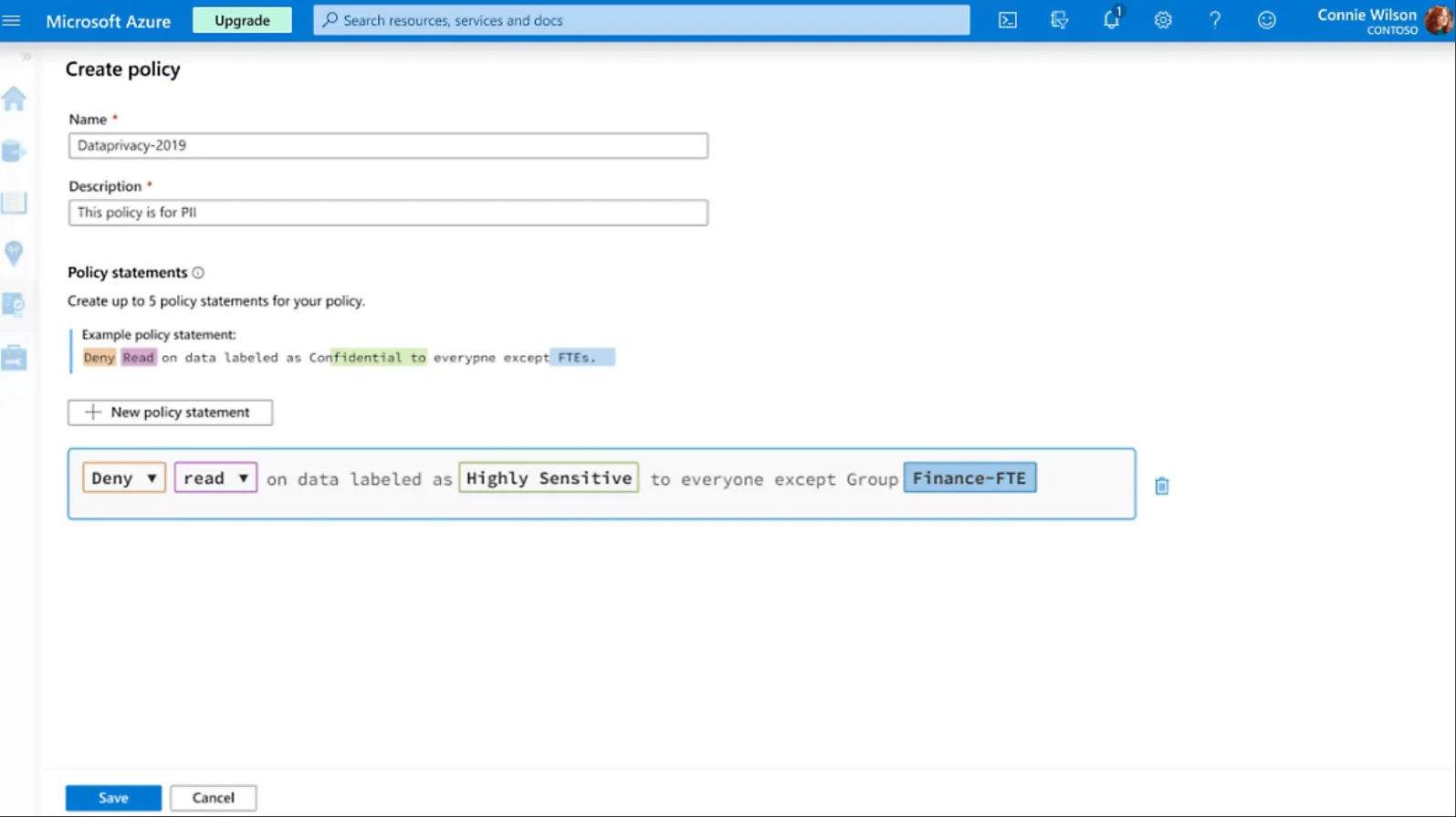
Microsoft Purview Data Policy - Image by Microsoft Purview.
Additionally, you can share data within your organization and across organizations (business partners and customers). These organizations must be within the same Azure tenant or across different Azure tenants. You can also track who the data is shared with/from, for each ADLSGen2 or Blob Storage account.
Now let’s explore how Databricks Unity Catalog supports your data governance strategy:
- Provides a unified interface to define access policies on data and AI assets
- Allows you to control access to data at the table, row, and column level with a low-code SQL interface — more granular than Purview’s offerings
- Leverages query federation to help you access data (at the catalog, schema, or table level) from third-party sources, such as PostgreSQL, MySQL, and Snowflake
- Enables secure data sharing through Delta Sharing, a platform-agnostic open protocol to share assets externally with Databricks and non-Databricks users
While both Purview and Unity Catalog are equipped with decent security and access control features, they might not cater to all audiences and data sources.
For instance, Unity Catalog’s low-code interface implies the need for SQL proficiency. Meanwhile, Purview’s data sharing supports external data sharing, so long as they’re also Azure-based ecosystems.
Moreover, a lot of these features are recent and their complete potential isn’t fully established yet.
That’s where Atlan emerges as a well-established, complementary platform to these tools, supporting a diversity of users, use cases, and tools through a customizable and personalized approach, with:
- Granular (column-level) access policies for diverse users and groups that can be set using a no-code interface
- Custom masking and hashing policies for different types of sensitive data
- Classification and tagging for different types of data, which can be automatically propagated
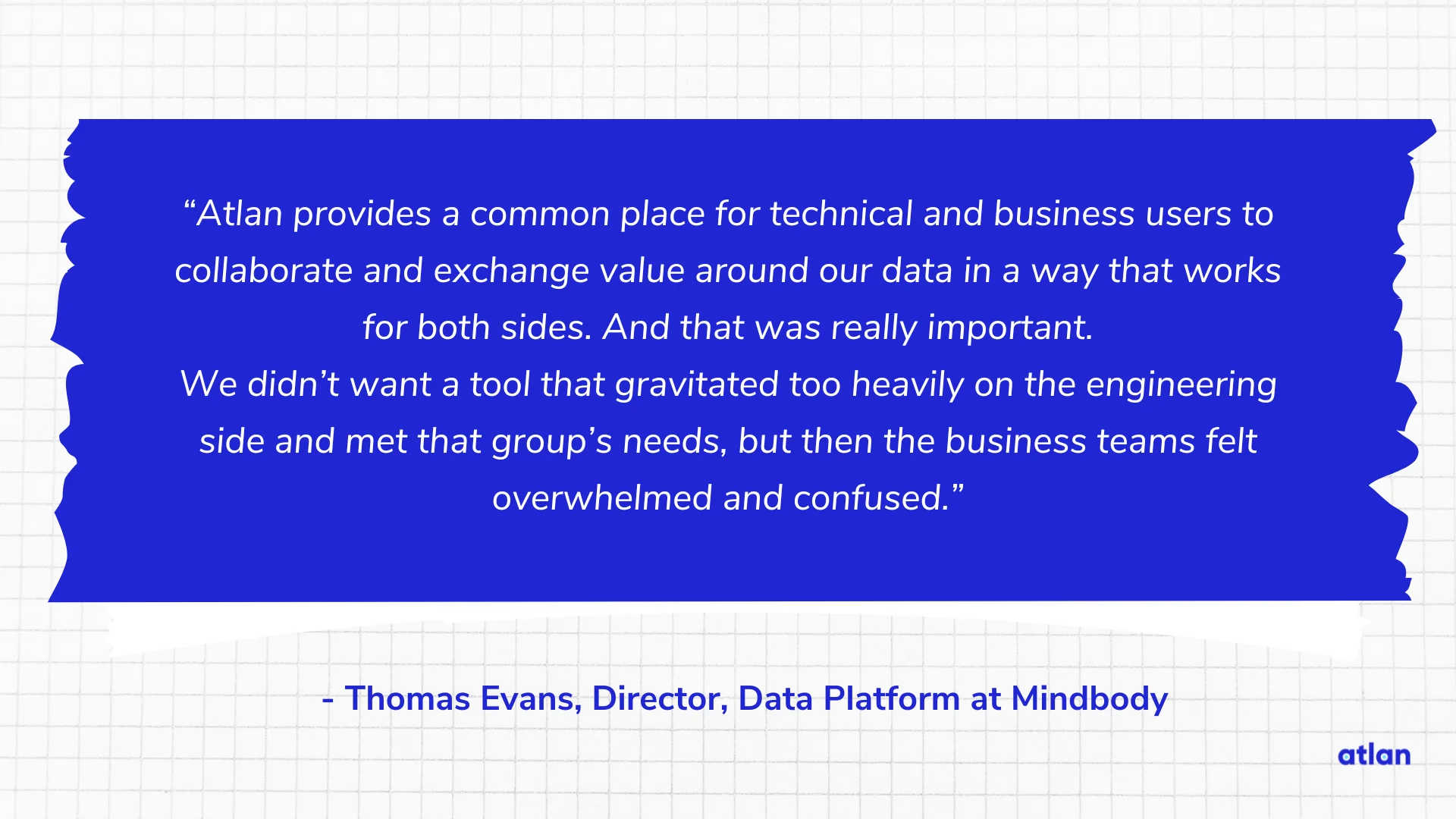
Now, let’s compare the integration capabilities of Microsoft Purview and Databricks Unity Catalog with your data stack.
4. Integration with existing tools #
When connecting your existing data infrastructure, Microsoft Purview and Databricks Unity Catalog offer different approaches that work well within their ecosystems.
Microsoft Purview supports seamless integration with the Azure stack. However, connecting non-Azure assets might be complex. While Purview offers APIs to connect with other tools in your stack, it could also lead to vendor lock-in over time.
Similarly, Unity Catalog integrates well with data assets within the Databricks environment, but for broader data ecosystem integration, additional solutions might be required.
Both tools are closed, proprietary systems with limitations in extensibility and flexibility for multi-cloud or hybrid data architectures. That’s why a best-in-class solution like Atlan can help you build an interconnected, living data ecosystem integrating all tools in your data stack.
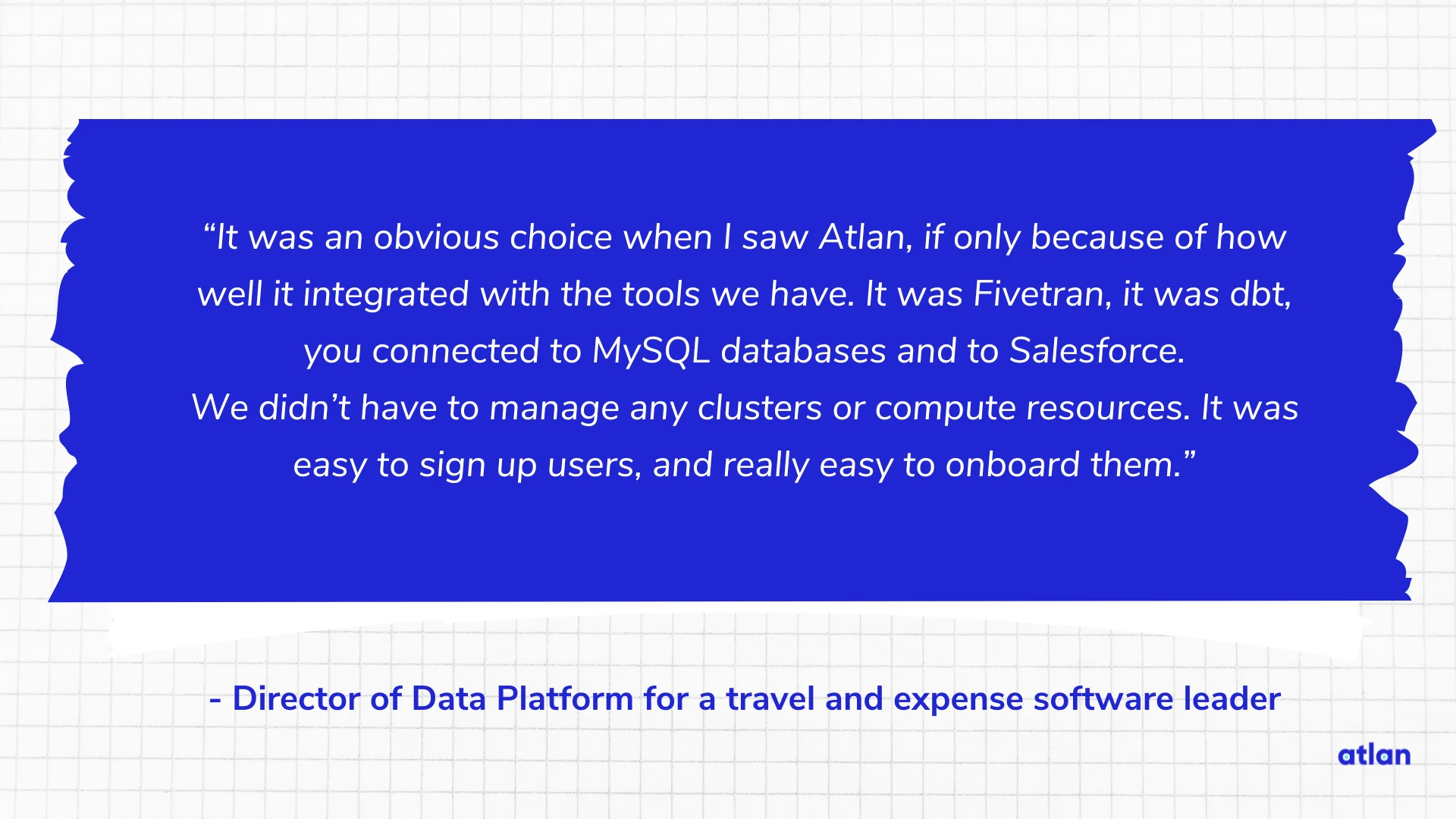
Next, let’s compare the costs of adopting Microsoft Purview vs Databricks Unity Catalog.
5. Cost #
Understanding the cost structure of each platform is crucial for informed decision-making, highlighting potential hidden costs and subscription considerations.
Microsoft Purview has a consumption-based pricing model, which can scale up significantly with larger data volumes and increased usage of advanced features. There are charges for scanning, classification, and cataloging of data assets.
For instance, Data Map (the app for metadata management) has a base fee for metadata storage and a per-operation cost, whereas the charges for scanning are based on duration and virtual core usage.
Other capabilities, like Microsoft Purview Data Catalog and Data Estate Insights, are free to use for basic features but incur charges for advanced capabilities like API calls for generating insights.
Databricks Unity Catalog is included with your current Databricks subscription, provided that you’re a Premium or Enterprise user. So, if you’re already heavily invested in the Databricks ecosystem, this might be a more prudent option.
However, it’s vital to note that both tools will require additional costs for implementation, customization, ongoing maintenance, training, and support. We recommend contacting Microsoft and Databricks directly for accurate pricing estimates based on your specific usage patterns and requirements.
Lastly, let’s look at deploying and managing Microsoft Purview and Databricks Unity Catalog.
6. Deployment and management #
Deploying and managing these data catalogs involve distinct processes, here are the deployment options available for Microsoft Purview and Databricks Unity Catalog, focusing on security considerations and configuration steps.
Microsoft Purview is a cloud-native SaaS (Software as a Service) solution, meaning it’s hosted and managed by Microsoft. All you need is to create a Microsoft Purview account using your Azure portal. So, deployment primarily involves provisioning the service and configuring connections to your data sources, without any complex infrastructure setup.
Similarly, Databricks Unity Catalog is integrated within the Databricks workspace and is automatically enabled for new customers. All you need is a Databricks workspace on the Premium plan or above. There’s minimal administrative overhead.
Microsoft Purview vs Databricks Unity Catalog: Enriched data governance with Atlan #
As mentioned earlier, both Microsoft Purview and Databricks Unity Catalog offer valuable functionalities, but they have limitations, particularly for organizations with multi-cloud or hybrid data architectures.
Atlan enhances and complements Microsoft Purview and Databricks Unity Catalog by extending their reach to a broader data landscape. Atlan provides deeper functionality (discovery, lineage, automation) and is configurable and flexible for diverse teams and stacks.
While we’ve already discussed Atlan’s capabilities for discovery, lineage, security, access, and extensibility, there’s yet another aspect of differentiation — Atlan isn’t a mere vendor, but a trusted partner invested in your success.
Other companies assign you a success manager and leave the rest to you, whereas Atlan goes above and beyond to:
- Create a custom strategy and implementation plan for your organization
- Help you reach widespread adoption of the first use case in less than 90 days
- Roll out additional use cases throughout the year, based on your custom plan
- Guide you on adopting modern paradigms like data mesh, data products, and data contracts
- Drive awareness and adoption through user interviews, workshops, and gamification
Here’s how SouthState Bank benefited from adopting Atlan as a partner addressing their unique needs:
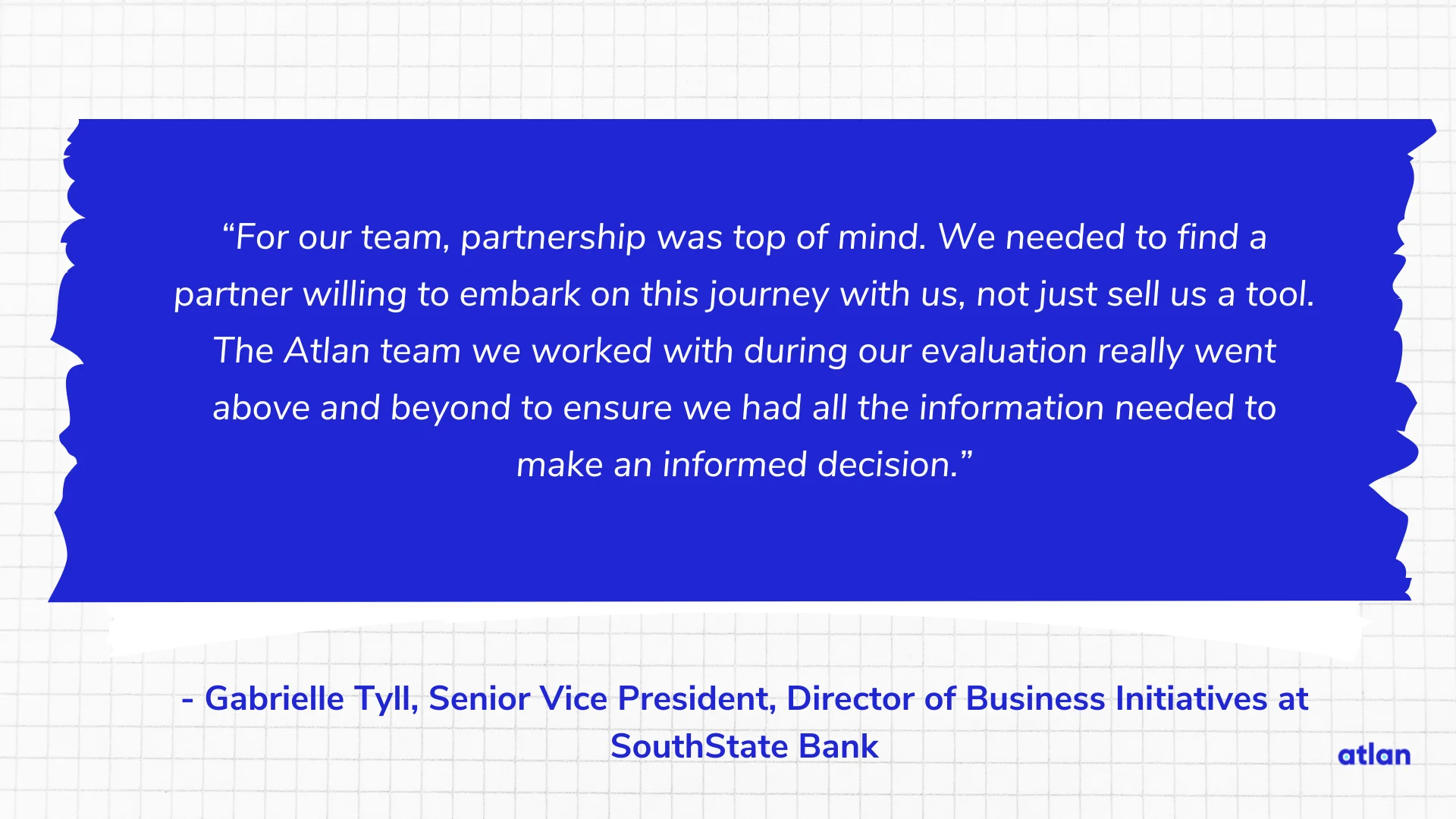
In the table below, we’ve compiled the numerous benefits of Atlan, compared with Microsoft Purview and Databricks Unity Catalog.
Atlan vs Microsoft Purview vs Databricks Unity Catalog: Comparison table #
Factor | Microsoft Purview | Databricks Unity Catalog | Atlan |
|---|---|---|---|
Data Discovery | Broad search capabilities across on-premises, multi-cloud, and SaaS sources, with natural language search, business domain filtering, AI-powered recommendations | Focuses on data and AI assets within the lakehouse, providing insights like data popularity and freshness, but with a simpler search interface displaying basic metadata | Extends scope beyond Microsoft and Databricks, connecting to a wider range of data sources — providing a single-pane search and discovery platform across your entire data estate |
Lineage | Entity and column level tracking of your Azure assets; captures job execution status, allows custom lineage definitions | Automatic, granular lineage capture within the Databricks workspace, including column-level transformations for any code | Extends lineage across multiple systems and platforms, providing a single pane of glass. Offers actionable lineage with embedded collaboration. |
Security & access control | Role-based access control (RBAC), data sharing within and across Azure organizations, data policy management, and AI-powered security Copilot | Fine-grained access control at table, row, and column levels, along with data sharing through Delta Sharing and query federation with third-party sources | Complements existing tools with granular, no-code access policies, custom masking, automated classification propagation for enhanced security, and more. |
Integration with existing tools | Seamless integration with the Azure stack and APIs for connecting other tools | Limited integration capabilities, works well within Databricks environment | Enhances integration with native connectors and open APIs for a wide range of tools and platforms, enabling a more connected data ecosystem |
Cost | Consumption-based pricing model with charges for scanning, cataloging, API calls, and other advanced features | Free with Databricks Premium or Enterprise subscriptions | Offers a transparent pricing with no archaic licensing fees or vendor lock-in; Atlan comes with a DIY setup, intuitive UI, interactive walkthroughs and documentation— all of which lower your TCO |
Deployment and management | Cloud-native SaaS solution, easy to deploy via the Azure portal with minimal administrative overhead | Integrated within the Databricks workspace, automatically enabled for Premium or Enterprise users | Provides a cloud-agnostic data governance platform with DIY setup, deployment, and open APIs |
Beyond the basics: Elevate your data governance efforts with Atlan #
Choosing the right data governance tool is essential, and Atlan complements and enhances Microsoft Purview and Databricks Unity Catalog to unlock the full potential of your data governance initiatives.
By integrating seamlessly with existing tools, Atlan offers deeper functionality in discovery, lineage, security, and access control, and provides personalized support and adoption strategies. Book a demo.
Microsoft Purview vs Databricks Unity Catalog: Related reads #
- What is Data Governance? It’s Importance, Principles & How to Get Started?
- Federated Data Governance: Principles, Benefits, Setup
- Benefits of Data Governance: 4 Ways It Helps Build Great Data Teams
- Data Governance Framework: Examples, Templates, Best Practices & How to Create a Data Governance Framework?
- Data Governance Policy: Examples, Templates & How to Write One
- 7 Best Practices for Data Governance to Follow in 2024
- Data Governance Readiness Assessment: A Step-by-Step Guide
- Data Governance Roles and Responsibilities: A Quick Round-Up
- Automated Data Governance: How Does It Help You Manage Access, Security & More at Scale?
- Data Governance and Compliance: Act of Checks & Balances
- How to Drive Business Value With Data Governance?
- A Guide to Gartner Data Governance Research — Market Guides, Hype Cycles, and Peer Reviews
- 5 Popular Data Governance Certification & Training in 2024
Share this article











